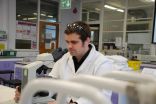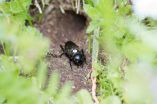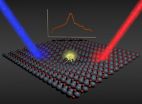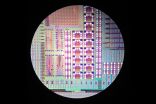Taming polluters: Ratings have spillover effects, leading to reduced toxic emissions
Firms reduce pollution more when their peers are also rated
2015-04-23
(Press-News.org) A new study by the University of Chicago Booth School of Business Assistant Professor Amanda Sharkey and University of Utah Assistant Professor Patricia Bromley found that environmental ratings have spillover effects on other companies' behavior. Rated firms reduce their toxic emissions even more when their peers are also rated. In addition, rated peers can even motivate some unrated companies to reduce their emissions.
The research is unusual in that the role of peers in conditioning how firms respond to ratings systems has received little examination.
The study, "Can Ratings Have Indirect Effects? Evidence from the Organizational Response to Peers' Environmental Ratings," found that being rated, regardless of the rating received, did prompt a company to reduce its toxic emission, consistent with prior research. But it went a step further to discover that, on average, the more peers that were rated in an industry, the greater a rated firm's drop in emissions.
The researchers looked at the indirect effects of environmental rankings, paying special attention to how manufacturers that were excluded from the rankings reacted as more of their peer companies were rated on their ability to lower toxic emissions. Surprisingly, even companies that were not rated changed their behavior knowing that their peers were being evaluated. However, the spillover effect on unrated firms occurred only in highly regulated industries.
"If managers believe their firms will be rated eventually--an expectation that may be especially strong if many of their peers are already rated--they may take immediate steps to reduce their emissions," the report said.
The researchers focused on the environmental ratings of public firms in the United States issued by KLD Research and Analytics, Inc., a pioneer in socially responsible investing. They also relied on data that firms are required to report to the government about their pollution levels.
One key discovery of the research is the potential for ratings systems to drive field-wide change when only some firms are formally subject to evaluation. This is important because many ratings systems are not comprehensive in their coverage, and there has been little evidence on the reactions of unrated firms.
INFORMATION:
The American Sociological Review published the study in its February 2015 issue.
From: Susan Guibert, Chicago Booth Office of Media Relations, 773.702.9232 (office), Susan.Guibert@chicagobooth.edu.
ELSE PRESS RELEASES FROM THIS DATE:
2015-04-23
SINCE its first use in the 1980s - a breakthrough dramatised in recent ITV series Code of a Killer - DNA profiling has been a vital tool for forensic investigators. Now researchers at the University of Huddersfield have solved one of its few limitations by successfully testing a technique for distinguishing between the DNA - or genetic fingerprint - of identical twins.
The probability of a DNA match between two unrelated individuals is about one in a billion. For two full siblings, the probability drops to one-in-10,000. But identical twins present exactly the same ...
2015-04-23
This news release is available in German.
An individual's behaviour in risky situations is a distinct personality trait both in humans and animals that can have an immediate impact on longevity. Researchers from the Max Planck Institute for Ornithology in Seewiesen have now found differences in personality types for the first time in a population of free living field crickets. Risk-prone individuals showed a higher mortality as they stayed more often outside their burrow where they can be easily detected by predators, compared to risk averse individuals. Moreover, ...
2015-04-23
Navigating through a cluttered environment at high speed is among the greatest challenges in biology - and it's one virtually all birds achieve with ease.
It's a feat David Williams hopes to understand.
A former post-doctoral fellow in the lab of Andrew Biewener, the Charles P. Lyman Professor of Biology, and a current post-doc at the University of Washington, Williams is the lead author of a study that shows birds use two highly stereotyped postures to avoid obstacles in flight. The study could open the door to new ways to program drones and other unmanned aerial ...
2015-04-23
This news release is available in German.
Researchers of Karlsruhe Institute of Technology (KIT) have unveiled an important step in the conversion of light into storable energy: Together with scientists of the Fritz Haber Institute in Berlin and the Aalto University in Helsinki/Finland, they studied the formation of so-called polarons in zinc oxide. The pseudoparticles travel through the photoactive material until they are converted into electrical or chemical energy at an interface. Their findings that are of relevance to photovoltaics among others are now published ...
2015-04-23
A Spanish-led team of European researchers at the University of Cambridge has created an electronic device so accurate that it can detect the charge of a single electron in less than one microsecond. It has been dubbed the 'gate sensor' and could be applied in quantum computers of the future to read information stored in the charge or spin of a single electron.
In the same Cambridge laboratory in the United Kingdom where the British physicist J.J. Thomson discovered the electron in 1897, European scientists have just developed a new ultra-sensitive electrical-charge sensor ...
2015-04-23
How long is the way from the city hall to the train station? When we estimate distances, something curious happens: short distances seem longer, and long distances shorter than they really are. Similar biases occur during judgments of volume, brightness or time. Psychologists call this phenomenon Vierordt's law. Its independence of the involved sensory systems suggests that our brain possesses universal principles for the assessment of physical quantities. However, where do the characteristic estimation biases stem from? In collaboration with colleagues from Zurich, neuroscientists ...
2015-04-23
It's a common dilemma faced by many working parents: your child has a cough or a cold, do you send them to nursery?
Researchers from the University of Bristol have, for the first time, investigated the process of decision-making that parents go through when faced with this situation. The research, published in The Journal of Public Health, reports that parents viewed coughs and colds as less serious and not as contagious as sickness and diarrhoea symptoms.
This resulted in many parents sending their child to daycare with a respiratory tract infection (RTI), which can ...
2015-04-23
In response to an article published by Chinese scientists describing research that used gene editing technologies in human embryos, the International Society for Stem Cell Research (ISSCR) has again called for a moratorium on attempts at human clinical germline genome editing while extensive scientific analysis of the potential risks is conducted, along with broad public discussion of the societal and ethical implications. The research article, entitled "CRISPR/Cas9-mediated Gene Editing in Human Tripronuclear Zygotes," was published online on April 18 in the scientific ...
2015-04-23
Imagine a day when scientists are able to alter the DNA of organisms in the lab in the search for answers to a host of questions. Or imagine a day when doctors treat genetic disorders by administering drugs designed to alter a patient's genome.
It may sound like science fiction, but with the development of genome-editing proteins like Cas9 and CRISPR, it could one day become science fact.
Before that happens, however, scientists must overcome a number of challenges, including how to improve the specificity of these proteins- the rate at which genome-editing proteins ...
2015-04-23
A more intellectually demanding job may be the key to living longer after developing young-onset dementia, according to health researchers.
Degeneration of the frontal and temporal parts of the brain leads to a common form of dementia affecting people under the age of 65. It results in changes in personality and behavior and problems with language, but does not affect memory.
"[Our] study suggests that having a higher occupational level protects the brain from some of the effects of this disease, allowing people to live longer after developing the disease," said Lauren ...
LAST 30 PRESS RELEASES:
[Press-News.org] Taming polluters: Ratings have spillover effects, leading to reduced toxic emissions
Firms reduce pollution more when their peers are also rated




